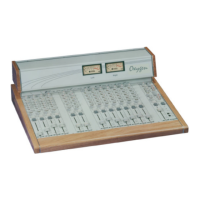The Mic/Line Input module is a mono input controlled by a button switch to select either
Mic (INPUT A) or Mono Line (INPUT B). A LED glows red when the INPUT B is selected.
The B Input is via a 1/4” Jack connector and it is set for mono signals providing a LINE
level such as RadioMic receivers, ISDN codecs.
There is a coarse adjustment for A input with multi-turn control recessed at the top of the
module. It allows you to adjust the gain by up to 40 dB. In conjunction with the GAIN
potentiometer (see) this allows you to adjust the overall gain to any desired figure within
the available range.
A jumper inside the module (J1) is available to apply phantom power to microphone A
input. An unbalanced INSERT socket (A) is provided which is a break point in the input
channel signal path.
The selected A or B source is fed through a common GAIN potentiometer that provides
a variable 30dB range from -15 to +15dB gain to match the connected source to the
internal 0 dBu operating level.
The Equaliser (available as an option – ref. to Section Errore. L'origine riferimento
non è stata trovata.) comprises four sections. The upper control provides H.F.(treble)
boost and cut of +/-15dB at 13 kHz, and the lower control provides L.F. (bass) boost and
cut of +/-15dB at 100 Hz. The centre two knobs is arranged as MID frequency section,
with a cut/boost control (lower knob) of +/- 15dB, and a frequency control which
determines at which frequency the boost/cut action will be centered (the centre band can
be swept from 300 Hz to 4.8 kHz). This MID section is particularly versatile for speech,
enabling particular characteristics of the presenter to be lifted or suppressed very
precisely. Set the cut/boost control of each section to the centre-detented position when
not required.
The signal is then routed via a Pan control and the two stereo routing switches to
either the main stereo programme (MASTER) or the stereo subgroup (SUB). There is a
red LED inside each switch which will illuminate accordingly.
The pre-fade listening. PFL button mode allows pre-fade listening (post pan-pot) of the
channel with the fader closed. When the PFL button is activated, the channel signal will
be connected to the PFL output and to the meters circuitry (see also METERBRIDGE
Chapter). Even when the channel is active, the PFL system is active. It always operates
in the SINGLE Mode (i.e. only one PFL is active at once). The PFL function can be
cancelled:
ALPS N-type 90° ultra smooth 100 mm sliders are provided on series.
On request, to notify at order, ALPS K series and ALPS K/VCA series sliders can be
also fitted, the last ones controlling an internal high quality VCA circuitry. There is no
audio going through the VCA faders. VCA faders do not therefore suffer from such
severe noise and signal loss problems that conventional faders may have when wear
and tear causes the resistive surface to deteriorate. The benefit is longer fader life, as
the crackles and dropouts typical of the traditional audio faders are smoothed out.

